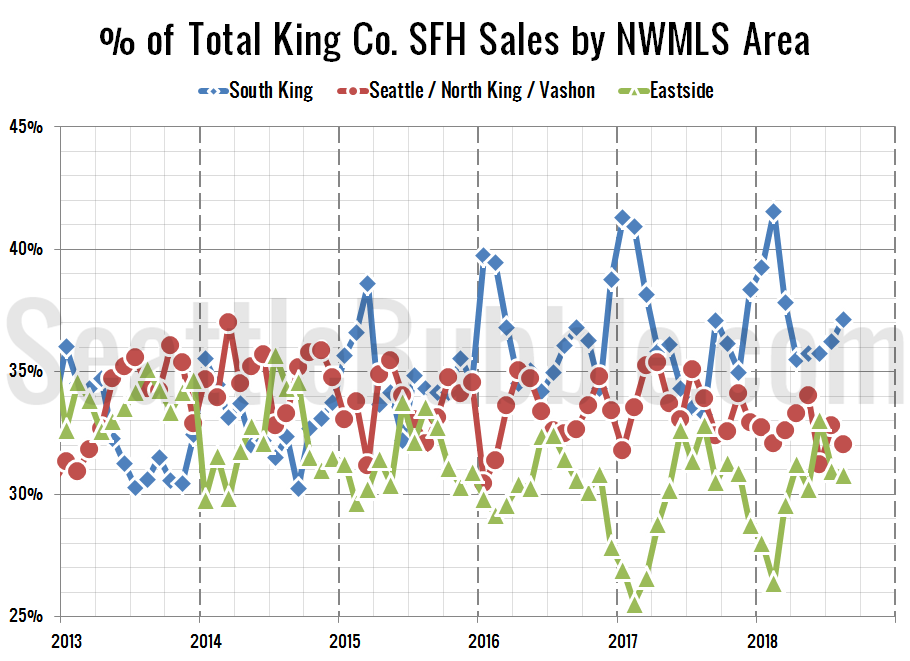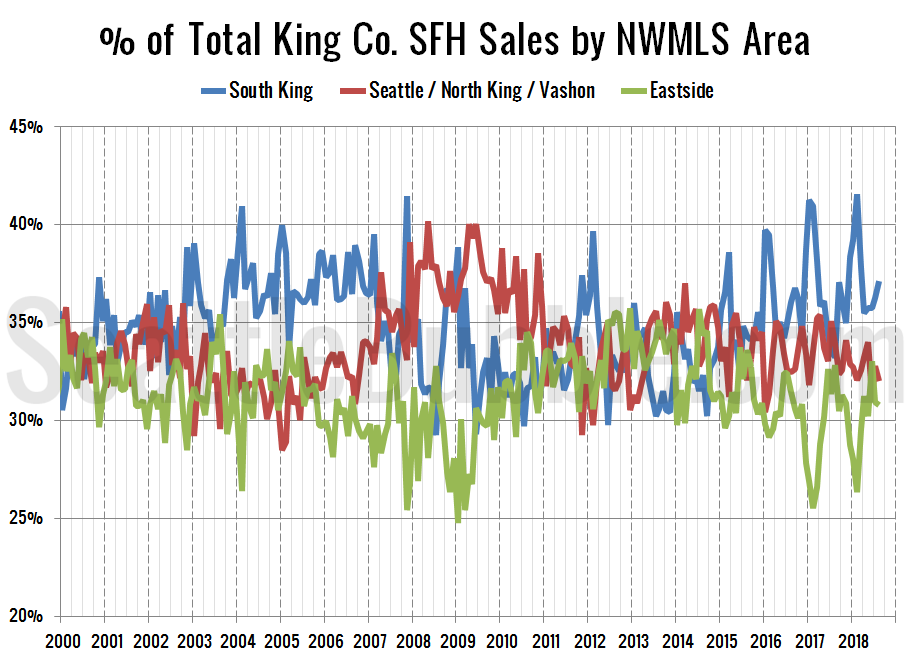Get unlimited access to the full spreadsheets used to make the charts in this and other posts, and support the ongoing work of this site by becoming a member of Seattle Bubble.
It’s been six months since we took a look at the in-county breakdown data from the NWMLS to see how the sales mix shifted around the county. I like to keep an eye on this not only to see how individual neighborhoods are doing but also to see how the sales mix shift affects the overall county-wide median price.
In order to explore this concept, we break King County down into three regions, based on the NWMLS-defined “areas”:
- low end: South County (areas 100-130 & 300-360)
- mid range: Seattle / North County (areas 140, 380-390, & 700-800)
- high end: Eastside (areas 500-600)
Here’s where each region’s median prices came in as of August data:
- low end: $380,000-$588,500
- mid range: $599,000-$1,060,000
- high end: $786,500-$2,557,500
First let’s look at the percentage of each month’s closed sales that took place in each of the three regions.
It’s interesting that in each of the last four years the share of sales in the South King regions has peaked in the first quarter and then fallen off sharply. However, this year unlike recent years the share of sales in the cheaper parts of the county has remained a few points higher than the other two tiers throughout the summer. The last couple months has even seen the share of sales in the cheap parts of the county gaining ground, which is probably a big part of why the county-wide median price has been falling.
The number of sales in all three tiers has been decreasing month-over-month for the past two months. Month-over-month sales were down five percent in the low tier, down ten percent in the middle tier, and down eight percent in the high tier.
Meanwhile, year-over-year sales are falling considerably in the middle and high tiers and are down moderately in the low tier. Compared to a year ago, sales decreased five percent in the low tier, fell nineteen percent in the middle tier, and dropped twenty percent in the high tier.
As of August 2018, 37.1 percent of sales were in the low end regions (up from 33.2 percent a year ago), 32.0 percent in the mid range (down from 33.9 percent a year ago), and 30.8 percent in the high end (down from 32.9 percent a year ago).
Here’s that information in a visual format:
Here’s an updated look at the percentage of sales data all the way back through 2000:
We’re still seeing the same pattern this year that we saw during the bubble years of 2004-2006—a much larger percent of sales taking place in the low tier regions and a lower sales share for the high tier Eastside regions.
Finally, let’s have a look at each region’s (approximate) median price (actually the median of the medians for each area within the region).
The median prices in the high and middle tiers have both fallen off over the last few months, but the low tier has held fairly steady. Month-over-month, the median price in the low tier fell two percent, the middle tier decreased nine percent, and the high tier lost three percent.
Twenty-five of the twenty-nine NWMLS regions in King County with single-family home sales in August had a higher median price than a year ago, while just nine had a month-over-month increase in the median price.
Here’s how the median prices changed year-over-year. Low tier: up 10.9 percent, middle tier: up 0.3 percent, high tier: up 7.6 percent.



